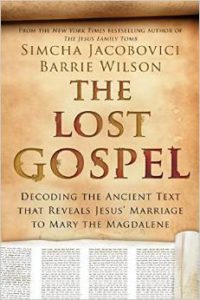More dramatic proof that Jesus and Mary Magdalene were married
 Last week, at the British Library in London, Professor Barrie Wilson and I launched our book, The Lost Gospel: Decoding the Ancient Text that Reveals Jesus’ Marriage to Mary the Magdalene .
Last week, at the British Library in London, Professor Barrie Wilson and I launched our book, The Lost Gospel: Decoding the Ancient Text that Reveals Jesus’ Marriage to Mary the Magdalene .
The press took notice. I lost track after 1500 international articles. You know you’ve really made it when Conan O’Brien and Bill O’Reilly comment on your book on the same day.
I prefer Conan’s comment. He said something to the effect that he hadn’t realized that Jesus had a wife and kids – didn’t he suffer enough? As for O’Reilly, he called me all kinds of names, including “dubious” and “stupid”. He did all this without even reading the book, which just goes to show how much more intelligent than me he is. I always need to read a book before I can express an opinion about it. But not Bill. Just to show you how stupid I am, I hereby challenge O’Reilly to a debate about our book and about the historical Jesus. I may be stupid, but I’m not an intellectual chicken.
At the same time that he called me “stupid”, O’Reilly said that Jesus didn’t have any brothers or sisters, even though the Gospels say he did (Mark 6:3, Matthew 13:55-56)! As it turns out, according to O’Reilly, who it seems is an expert on first-century Judaea, all Jews at the time called each other “brother” and “sister”, if they lived in the same village. That’s actually totally false, though it is true of certain areas of Tel Aviv today where, after partaking of a certain weed, Tel-Avivis call each other “bro” and “sis”, even if they don’t live in the same neighborhood. C’mon, O’Reilly, debate the stupid guy.
There’s been praise for the book – no doubt about it. For example, the Herald Scotland called it “[An] explosive text… a closely argued case… The Lost Gospel is impressive and enlightening… a detective story [that is] fascinating and challenging, in equal measure.” It’s also heartwarming that Amazon is temporarily out of stock of our book, and that ours is the #1 history book on Amazon.
But the main criticism is that we shouldn’t substitute Jesus and Mary Magdalene for Old Testament characters in ancient Christian texts. Well, if that’s the case, all of our critics should really get mad at the author of the Gospel of Matthew. At one point in Jesus’ public ministry, there’s a crowd around him, and they ask Jesus for a miraculous sign. In the Gospel of Mark, Jesus refuses to give a sign. In the Gospels of Matthew and Luke, however, Jesus speaks in code. He says he’s willing to give one sign and one sign only – “the sign of Jonah” (Luke 11:29). Luke does not explain the meaning of the sign, but Matthew decides to decode it. He says, “For as Jonah was three days and three nights in the belly of the great fish, so will Son of Man be three days and three nights in the heart of the earth” (Matthew 12:40). In other words, Jesus speaks about an Old Testament prophet named Jonah, and Matthew chooses to interpret this as a code. According to Matthew, when Jesus is speaking about Jonah, he’s really speaking about himself, predicting his own resurrection. But where are the howls of derision? Why doesn’t Bill O’Reilly call Matthew “stupid”? Why doesn’t he call him a “fraud”? Why doesn’t he say that he’s in it for the money? Because, when Matthew decodes, it conforms to Paul’s version of Christianity, to which O’Reilly subscribes. But when Jacobovici and Wilson decode, it conforms to the real-life Jewish Rabbi of the first century, who lived and died in Israel, and who never made it to America.
So if we put behind us the statements driven by blind theology, and we return to the context in which our “Lost Gospel” was created, i.e., Syriac Christianity, what do we find? We find, for example, Ephrem the Syrian. Ephrem was born at the beginning of the fourth century, and he was one of the most distinguished leaders in Syriac Christianity. He wrote commentaries on the Bible, preached sermons and composed many hymns. Because of his poetic eloquence, he was nicknamed “Harp of the Holy Spirit” by his fellow Christians. As it turns out, Ephrem agrees with us, not with Bill O’Reilly. Ephrem equates Jesus with the Joseph of Genesis. He then goes further. In Hymn 21, he tells us that Aseneth, wife of Joseph, Jesus’ avatar, “had many children by the Crucified”.

Using the typology, i.e. the decoding methods of Syriac Christianity, substituting Mary Magdalene for the Aseneth of Genesis, this is what Ephrem the Syrian had to say some 1600 years ago:
“Aseneth [i.e. Mary the Magdalene] is the symbol of the Church of the Gentiles.
She loved Joseph [i.e. Jesus] and Joseph’s [i.e. Jesus’] son…
in truth, the Holy Church loved.
Aseneth [i.e. Mary the Magdalene] had many children by the Crucified,
And every one of them is marked with the cross.”
Unless Aseneth time-travelled, and had relations with Jesus and “many children by the Crucified”, what you just read is a fourth-century testament by a leading Christian theologian attesting to the historical accuracy of our Lost Gospel – a tale of love and marriage and sexual relations that resulted in “many children”, all of them marked for death by the authorities. No wonder they wrote in code.

